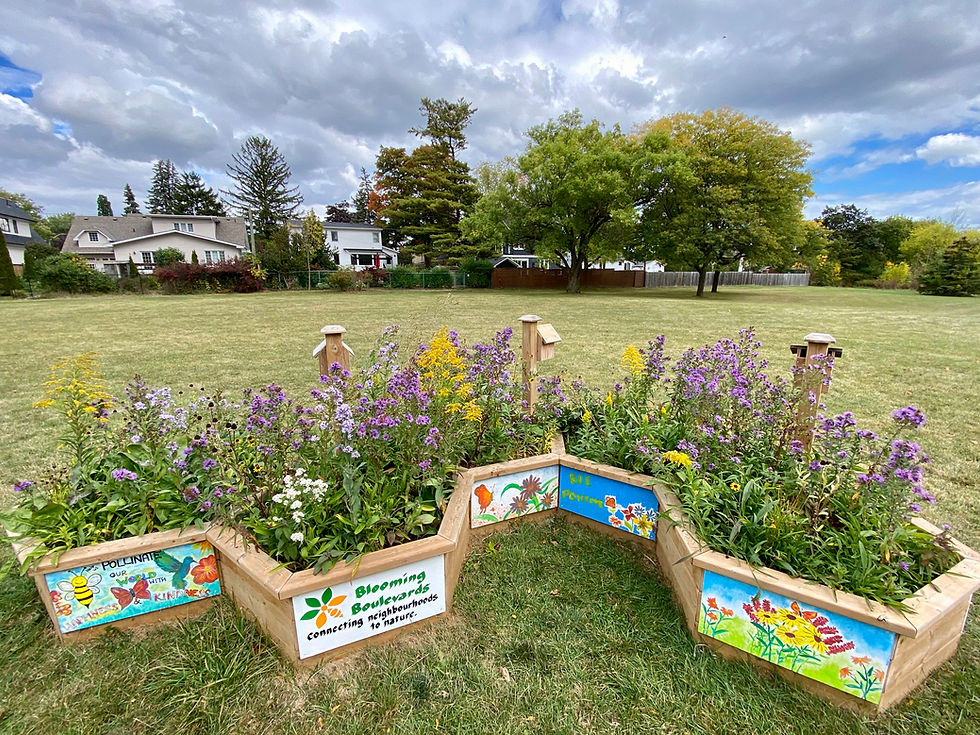My life as a propagator
- Jeanne McRight

- May 27, 2022
- 4 min read
By Sheila Cressman

It all started in the autumn of 2019 when I attended two seed gathering workshops with Jeanne McRight at Hancock Woodlands and Jack Darling parks. She spoke about how easy and enjoyable it was to propagate your own native plans. Jeanne arranged a letter of permission from the City of Mississauga to collect a few seeds from certain species of wild native plants in several municipal parks. So I gathered seeds from black-eyed Susans, New England asters and Virginia mountain mint, then stored them in my fridge with the vague idea that I would be doing something with them. I learned how to process and stratify the seeds at a later workshop, and having invested all that effort into these seeds, I figured I had to see if they’d actually germinate.
Early spring rolled around, and with a mild push from Jeanne, I headed to Bustan’s in Toronto, where I picked up some lights for the new shelving unit I had just acquired. The lights can be a bit of a challenge, but with some guidance from both Jeanne and Wayne, everything was set up just a couple days before the first pandemic lockdown began.
I was thrilled and amazed when the first seedlings germinated just a few days later. With daily attention and by following the simple directions Jeanne provided, I was able to produce dozens of plants for both Blooming Boulevards' stewards and for my own boulevard garden. I am by no means a gardening expert, so it was a revelation for me to think that I could produce native plants for my own use, rather than spending several hundred dollars each season at a garden centre for ornamental plants that probably started their lives in a lab.

I have now completed three seasons of native plant propagation, and have produced over 400 plants, all in my cold basement. Here are my top 5 pieces of advice for anyone who wishes to follow the same path.
1. Cost is minimal.
There are some up front purchases needed for a shelving unit, soil, lights, trays and inserts.
The lights will be the most expensive items to purchase (I use Sunblaster T5 6400K daylight-balanced fluorescent grow lights). For me, one light per tray is sufficient, and reflectors are not needed.
I suggest a timer, otherwise, you will have to remember to turn the lights on and off daily to allow for 16 hours of light.
Soil-less potting mixture should be purchased in the fall as it’s often in short supply in early March, when seeds should be sown. I purchased a 60 pound (3.8 L) bag of ProMix BX which was a good investment.
There has been no noticeable increase in my electrical bill. Of course if you’re a Blooming Boulevards volunteer propagator, all the supplies are provided for you.
Below: My shelf unit and lighting setup. I have only one tray per shelf, so one light is enough. With wider or deeper shelves and more trays per shelf, you will need 2 or more lights per shelf to cover the entire planting area of all your trays.

2. It’s possible to propagate plants even in a cold basement.
However, pay close attention to the lights initially being approximately 4 inches from the top of the soil, and move them upwards as the plants begin to grow. Fertilization will assist and should be commenced with bottom watering as soon as the “true leaves” appear. Some plants may be small and grow more slowly due to the cold air, however, they can still be healthy and successfully transplanted. I found this to be the case particularly with hoary vervain, blue lobelia and hairy beardtongue.
3. Thinning is key.
Even if you hate to snip away at the wonderful mini plants that have poked up, if you don’t thin the multitude of little seedlings, it will be unmanageable and will detract from the vigor of the plants as a whole in that particular insert/cup or pot.
Below: These little seedlings are crowded and when a bit bigger, will need thinning to one or two per pot.
4. Some seeds will not germinate.
Sometimes there will be a low percentage of a particular species that germinates. There are a variety of reasons for this. Climate conditions may not have been ideal during the pollination period. Perhaps they were too wet when collected, or the seeds weren’t fully mature. Stratification time might be to blame. I gathered plenty of seeds this year and discovered that some of my seeds germinated poorly. Even so, the remainders turned into healthy plants, for which I am grateful.
5. Recommended species.
I have had good results with bee balm, dotted mint, Virginia mountain mint, anise hyssop, white yarrow, butterfly weed, black-eyed Susans, little bluestem, wild columbine, lanceleaf coreopsis and snakeroot.
In addition to providing plants for Blooming Boulevards' garden stewards, I have also given many away to friends and family who are happy to receive locally produced native plants. I have found plant propagation to be a surprisingly unexpected rewarding activity with year- round benefits.
Want to learn more? Visit Blooming Boulevards' YouTube channel for some informative videos.













Comments